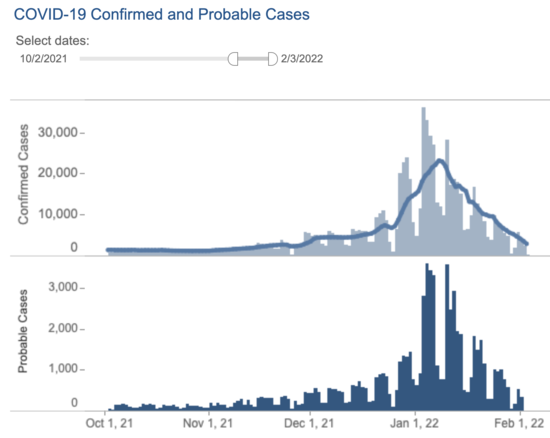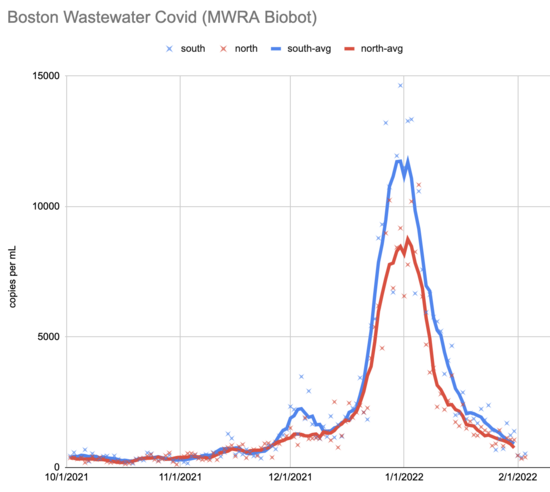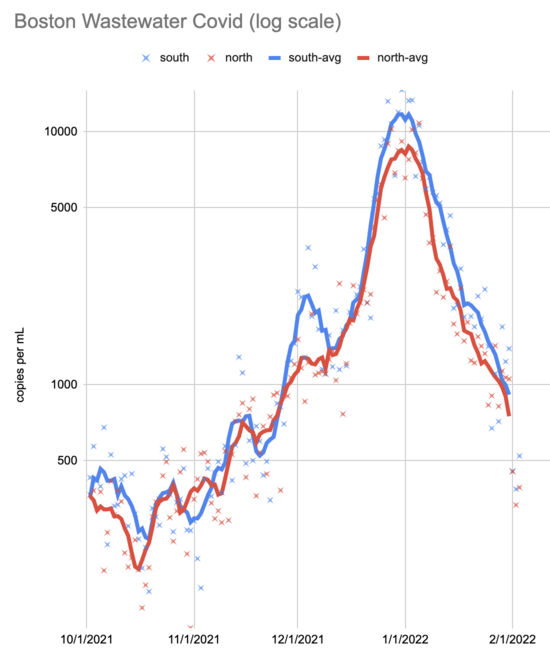The timing of the omicron spike was hard on everyone, but I felt especially bad about how it impacted Lily (7y) and Anna (5y). For months we had been telling them that while they couldn't do various things they would be able to do them once they were fully vaccinated, and then two weeks—almost to the day—after their second shots Omicron hit our area. So, with the Omicron spike past us, it was really nice for them to be able to have their first indoor playdate with classmates yesterday.
We, and their classmates parents, were ok with it because of how covid has progressed here:
Statewide Cases (MA DPH):
Boston Wastwater Data (MWRA):
The trend is a bit clearer on a log scale, where you can tell that levels are continuing to fall quickly:
Since Covid has been seasonal, similar diseases are also seasonal, and the pattern makes some sense, I expect levels will continue their decline, and stay low until next fall.
In addition to indoor playdates, here are some other things we're doing differently:
Hosting indoor gatherings: we're hosting an EA dinner next weekend (2/13). (We also hosted one just just before the Omicron spike, but we're not doing rapid tests this time.)
Organizing contra dances: the first BIDA contra dance since 2020 is in two weeks (2/20).
Planning international travel: we're going to the UK in late April.
On the other hand, we are still making some covid-related changes to our behavior, beyond what's required:
Nora (7m) is still quite young, in addition to being unvaccinated. While she's past the most vulnerable period and at this point her risks from getting sick are low, they will likely be even lower soon and levels are still falling quickly. We're not generally taking her indoors places if it's avoidable; for example, we wouldn't bring her along to go shopping.
Only vaccinated guests. We aren't having anyone over unless they are fully vaccinated (or too young to be), and we also wouldn't go over to a friend's house unless the people there were too.
Masks for large gatherings. For a dance like BIDA this is a local regulation, but for the EA dinner we could have chosen not to. This is a combination of trying to reduce risk and let more cautious people attend.
Not going to restaurants. This wasn't something we did very often pre-covid anyway, but since takeout is an option (and it doesn't require childcare) the marginal enjoyment of eating out doesn't feel like it outweighs the (small) risk.
I think it's pretty likely that sometime in the Spring levels will be low enough that we will be able to relax on most of these as well, but we'll think about that closer to the time.
Related: if you want to visit, either by coming over for dinner or after the kids go to bed, let me know?


